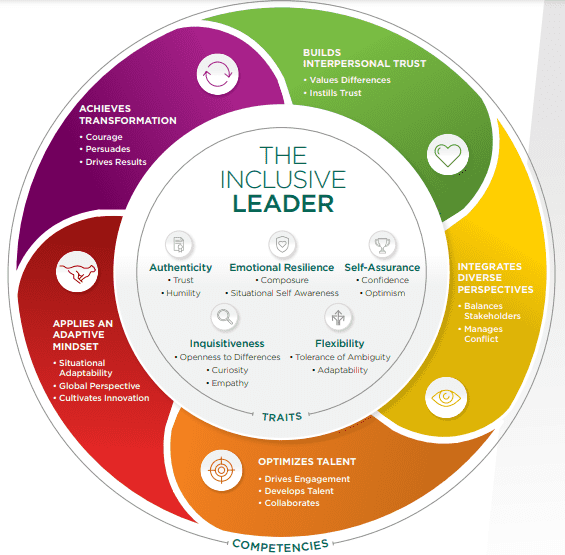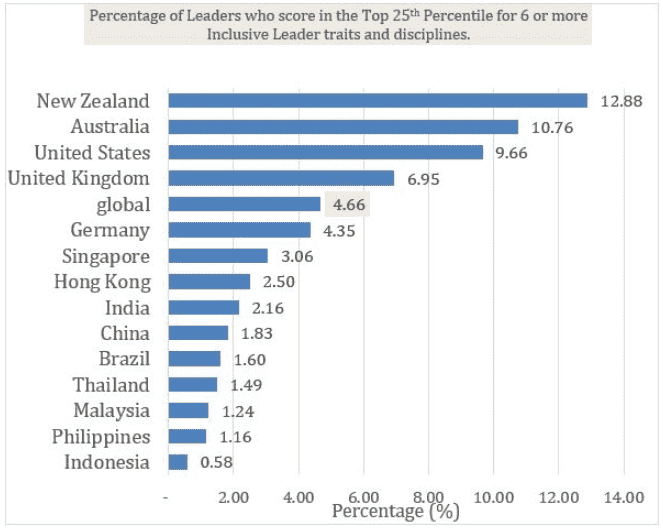In times of uncertainty and great change, it has never been more important for leaders to ensure their people feel connected and included. To engage effectively and with empathy, and to provide a feeling of psychological safety even when teams are apart.
So it’s concerning to see that just 1% of leaders in Malaysia could be defined as truly inclusive. In Korn Ferry’s recent assessment of over 24,000 global leaders, this means they scored in the top 25th percentile for six or more of the 10 inclusive leader traits and disciplines.[1]
At Korn Ferry’s recent webinar, Inclusive Leaders for a Transforming World, we brought together a panel of experts to explore what it takes to be genuinely inclusive. How some companies are making intentional steps towards greater diversity and inclusion, so they can overcome challenges and adapt to change.
“Our world is changing,” noted May Knight, President Asia Pacific Korn Ferry Consulting. “Many of our clients, across all industry sectors, are concerned with making their people feel valued, respected and safe. Creating truly equitable organisations, where they can attract the best people from talent pools that have not yet been tapped and where everyone can rise to their full potential.”
This is an opportunity. But unless you have leaders who are able to help their people navigate through the current difficulties, you may not be able to create the kind of cultural environment that will sustain organisational performance.
“If diversity is the mix, than inclusion is the behaviours that make that mix work,” explained Juliet Warne, Client Partner Korn Ferry Australia. “Without inclusion, you may have a diverse group of people but you won’t maximise the potential of what they can offer.”
Leaders need to leave prejudice at the door
Professor Michael Platow of Australian National University’s Research School of Psychology said diversity is part of the human condition, but this diversity in turn can “form the basis for negative attitudes and behaviours towards others ‘not Iike’ ourselves.” Whether it’s between men and women, or people from different ethnic or religious backgrounds or sexual orientation, these negative attitudes are commonly described as prejudices.
Professor Platow is currently leading research into this area through The Prejudice Census, a collaborative project between ANU, the University of Adelaide, Groningen University and Tel Aviv University.
“We are gathering information from a wide range of people around the world, and what’s interesting is that we all have a slightly different view of what prejudice is,” he said. “It may seem intuitive to us, but if we’re talking about different things we won’t be successful in instituting change at our organisations.”
For example, he said even non-minority male participants reported being targets of prejudice – and minority males reported prejudice at higher rates than minority females.
“This is important for leaders to understand, because without their intervention people will come to the workplace with these views. For me, leadership is about the creation, co-ordination and control of a shared sense of who we are and what we value as an organisation.”
“Leadership is about the creation, co-ordination and control
of a shared sense of who we are and what we value as an organisation.”
Professor Michael Platow, Australian National University
Unity through diversity
Professor Platow’s research emphasises the role of leadership in enhancing inclusion by focusing on ‘us’ as a team, not ‘me’ as a leader.
“This requires new behaviours and mindsets,” said May. “A new type of leader, who can take a collaborative approach rather than command and control. Who can create a safe space, regardless of what’s happening externally, where people feel accepted and empowered to perform at their best.”
The business case for inclusive leadership is well-established. Diverse and inclusive organisations outperform their peers: they are 33% more likely to have financial returns above their industry medians[2], and they are 70% more likely to capture new markets.[3] They are 75% more likely to bring a new idea to market[4], and almost 90% more likely to make better decisions.[5]
But there are risks if diversity is not managed well. Without effective inclusion, diverse organisations can become chaotic, leading to reduced productivity and engagement – and higher turnover.[6]
In the 21st century, finding new ways to create growth is a common challenge. It requires the ability to position a difference to the market – to innovate. To do this effectively, organisations need diversity – and to manage that diversity you need inclusive leadership.
But all this will not happen organically: it needs to be set as an intentional strategy.
“We need a new type of leader, who can take a collaborative approach
and create a safe space, regardless of what’s happening externally.”
May Knight, Korn Ferry Hong Kong
Drawing on personal experience
Korn Ferry assesses and develops more than 100,000 leaders a month around the world across four dimensions. Through continual analysis, research and discussions, we have observed the traits, competencies, experiences and drivers that make some leaders more effective than others.
Diversity can be acquired, and it can be inherent. In the same way, inclusion can be structural – the frameworks, processes and policies that support an inclusive environments – and it can be behavioural. This requires things like respectful leadership, open mindsets and relationship-building skills sets across the organisation.
“Inclusive leadership starts from the inside out,” explained Juliet Warne. “When we think about the inner world of leadership, it’s the traits we have as a leader and the personal biography – the experiences that have shaped our mindset and behaviours.”
She gave the example of a leader who held multiple roles in different countries across the Asia-Pacific region. “She built empathetic perspectives and cultural agility, and was able to nuance her leadership style to account for differences in her environment,” explained Juliet.
Early exposure to these diverse experiences can give leaders an edge, but they also need to consciously draw on learnings from their journey to lead more inclusively.
“Inclusive leadership starts from the inside out… the experiences that
have shaped our mindset and behaviours.”
Juliet Warne, Korn Ferry Australia
The traits and disciplines of an inclusive leader
Inclusive leaders are not only good leaders of inclusion and diversity, they are more effective leaders in general. And this is because they share some common traits and disciplines which also help them thrive through constant change, as Juliet outlined in the webinar.
“Inclusive leaders are authentic: they are honest and open,” she explained. “They are also emotionally resilient and self-assured – they can face the world with optimism and confidence. They are curious about other people, and flexible enough to adapt rather than operate with a rigid and fixed view.”
“We need this inner world, but we also need the skills and competencies to be an effective leader,” said Juliet.
The Five Disciplines of the Inclusive Leader

- Building and cultivating trust – by setting aside ego and finding common ground, inclusive leaders help people feel comfortable and safe
- Bringing together diverse perspectives – acknowledging that other ideas are valid and can help us solve bigger problems
- Make the most of the talent around them – motivating and inspiring others to create a high performance environment
- Having an adaptive mindset – can think quickly, and confront challenges with agility
- Able to achieve transformation – by empowering others to use their skills and strengths, this is what drives results.
“Inclusive leaders are not just about traits that might be considered warm or ‘soft skills’,” emphasised Juliet. “They also lead to genuine business outcomes.”
A rare combination
Inclusive leaders tend to fall into one of two categories: ‘heart-led’ and ‘head-led’. The first clusters more around people-oriented and talent-building capabilities, the second on action and results. However, effective inclusive leaders need to combine both of these dimensions.
And this is a significant challenge.
Having identified the dimensions of an inclusive leader, Korn Ferry analysed its database of more than 24,000 leaders to see how many ticked every single box.
Not one did.
“In fact, we couldn’t find any leaders who fell into the top 25th percentile across every trait and discipline,” noted Juliet. However, she sees this as an opportunity.
“Organisations can cultivate these inclusive leaders. We already have incredible diversity around us, and we’re facing unique challenges right now so there is also a degree of urgency.”
She noted New Zealand topped the ladder for inclusive leadership with almost 13% of leaders holding six or more relevant traits and disciplines, followed closely by Australia (11%) and the US (10%).
Globally, just 4.6% of leaders scored in the top 25th percentile for six or more inclusive leadership traits and disciplines.

Proactive steps to inclusive leadership
Clearly, you need to be intentional to cultivate inclusive leadership from within. Lee Yen Chin, Korn Ferry Client Partner based in Singapore, said she is seeing leaders “take proactive steps to enable communication, and reduce bias in decision making.”
“A tech company we work with needed to be able to create ‘psychologically safe’ teams quickly – because they knew the nature of their work meant project teams were constantly forming then disbanding,” she said.
Critical to this was ensuring people took ownership of participation through an open enrolment training program. “It helps employees build skills, and learn to support each other to speak up and experiment,” she explained.
Ensuring high potential female leaders are given opportunities is also priority – particularly in industries that have been quite male-dominated. “One of our pharmaceutical clients saw great results when managers were encouraged to actively sponsor participants and bring forward ‘heart’ leadership qualities.” In doing so, they created trust and momentum for participants.
Evidence can be invaluable – not just for building a business case for inclusion, but also for uncovering gaps. When a wealth management firm wanted to ensure it gave every team member opportunities to grow and thrive, it engaged Korn Ferry to conduct an organisational audit, using quantitative and qualitative data.
“This revealed some interesting insights into the lack of advancement of under-represented groups through the firm. There was a strong base at junior and mid-levels, but they were not being offered promotions,” explained Lee Yen Chin. Further analysis revealed the root cause: highly visible assignments were a predictive measure of advancement, and those under-represented groups were not being exposed to these opportunities.
By addressing this underlying issue, the firm could resolve another major issue: succession planning. It had a clear path to encourage high potential leaders to stay within the organisation – especially those from under-represented groups.
“We are seeing leaders take proactive steps to enable communication,
and reduce bias in decision making.”
Lee Yen Chin, Korn Ferry Singapore
Breaking down barriers
The pandemic has forced organisations to disrupt the way they do things, and re-think what it will take to grow in a very different market environment. Part of this may involve challenging long-held assumptions about your culture, and the types of leaders you will need to steer your organisation through the next wave of change.
For Lee Yen Chin, this means interrogating your business, using evidence-based frameworks like the Five Dimensions model. “Ask yourself, what has changed in the business, and what behaviours are still relevant for the future? What processes, systems and structures will you need in place to support that change going forward?”
In the process, you may be able to find some quick wins – such as building complementary skillsets into a predominantly heart-led or head-led leadership base.
Importantly, this cannot be seen as a compliance ‘tick-box’ exercise. To change deeply-held and often unconscious beliefs, and establish new behavioural or cultural norms, you need to give people the tools to build self-awareness and address any gaps.
Because when just 1% of leaders in Malaysia are only close to being defined as inclusive leaders, there is still room for improvement. And with that, comes opportunity to make positive change. Change that can delivery tangible results for your people, and for your business success in the future.
[1] Heart and Head: Inclusive Leaders for an Equitable Future, Korn Ferry, 2020. Based on 24,000 leaders assessed between 2015 and 2018 by Korn Ferry.
[2] Why Diversity Matters, McKinsey & Company, January 2015
[3] Diversity & Inclusion in Corporate Social Engagement, CECP, 2018
[4] Center for Talent Innovation research reveals vast majority of companies are losing out on innovation, 2013
[5] The 5 Disciplines of Inclusive Leaders, Unleashing the Power of All of Us, Korn Ferry <year>
[6] The 5 Disciplines of Inclusive Leaders, Unleashing the Power of All of Us, Korn Ferry <year>
This article was first published here.
Photo by Kyle Glenn on Unsplash.

 5.0
5.0 





















